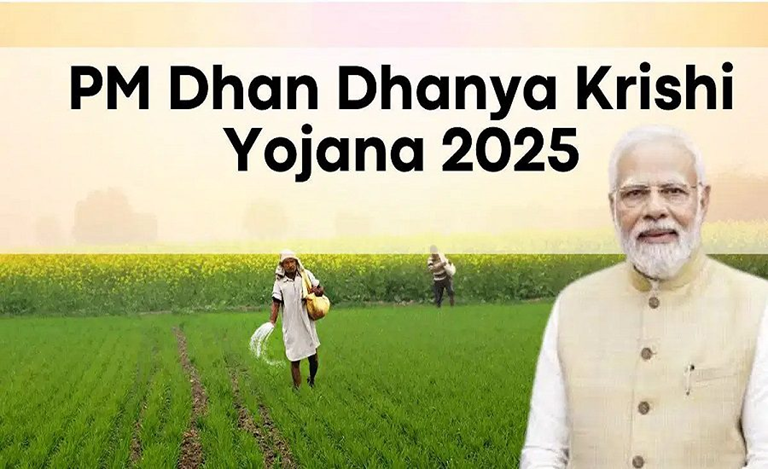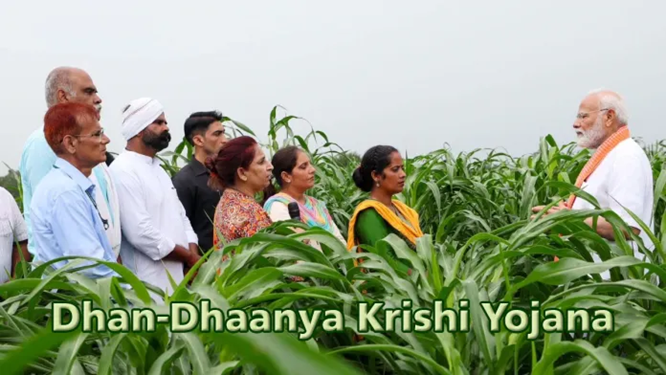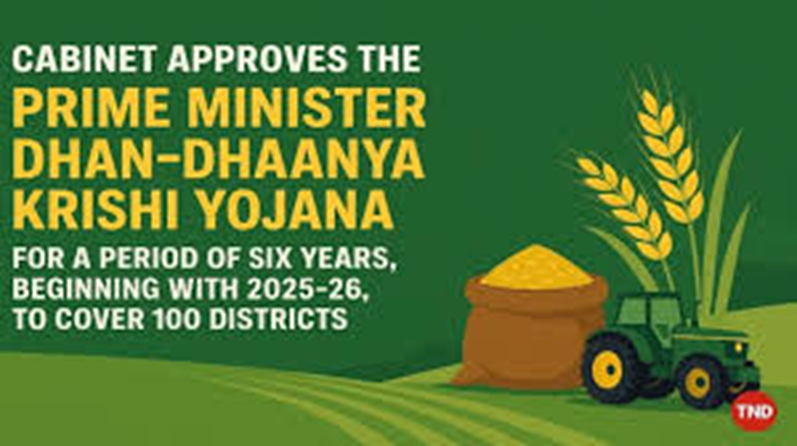Union Cabinet approved the Prime Minister Dhan-Dhaanya Krishi Yojana (PMDDKY), a scheme to develop 100 agricultural districts through the convergence of 36 schemes of 11 ministries. The scheme has an outlay of Rs 24,000 crore per year, and will be implemented for six years beginning with the current financial year, 2025-26.
Dhan-Dhaanya Krishi Yojana : India’s New Agri Revolution
Why In News
- Union Cabinet approved the Prime Minister Dhan-Dhaanya Krishi Yojana (PMDDKY), a scheme to develop 100 agricultural districts through the convergence of 36 schemes of 11 ministries. The scheme has an outlay of Rs 24,000 crore per year, and will be implemented for six years beginning with the current financial year, 2025-26.
Implementation On The Ground
- A master plan for the implementation of PMDDKY, which will include agriculture and allied activities, will be drawn up for every district, Information and Broadcasting Minister Ashwini Vaishnaw said.
- This District Agriculture and Allied Activities Plan will be prepared by the District Dhan Dhaanya Samiti headed by the Collector, and will have progressive farmers as members. “The District Plans will be aligned to the national goals of crop diversification, conservation of water and soil health, self-sufficiency in agriculture and allied sectors as well as expansion of natural and organic farming,” an official statement said.
- The plans will be based on extensive consultations and understanding cropping patterns and allied activities as per agro-climatic conditions. Committees will be set up at the district, state, and national levels for their effective implementation. Central Nodal Officers (CNOs) will be appointed for field visits, review and monitoring. Every district will have central and state agriculture universities as technical knowledge partners.
PMDDKY Districts Will Be Ranked
- PMDDKY is designed on the lines of the Aspirational Districts Programme (ADP) that was launched by Prime Minister Narendra Modi in January 2018 in the country’s 112 most underdeveloped districts, with the aim of transforming them quickly and effectively.
- The ADP is based on the 3 Cs, Convergence (of central and state schemes), Collaboration (of central and state level nodal officers and District Collectors), and Competition among districts through monthly delta ranking based on incremental progress in 49 Key Performance Indicators (KPIs) under five broad socio-economic themes: Health & Nutrition, Education, Agriculture & Water Resources, Financial Inclusion & Skill Development, and Infrastructure.
- NITI Aayog, which plays an important role in the implementation and monitoring of the ADP, will also provide “overall guidance and capacity building” support to PMDDKY.
- PMDDKY districts too will be ranked based on their performance. The progress of the scheme in each Dhan-Dhaanya district will be monitored on a monthly basis on 117 Key Performance Indicators, the statement said.
Aim Of The PMDDKY
- The scheme was announced by Finance Minister Nirmala Sitharaman in the Union Budget presented on February 1. “Motivated by the success of the Aspirational Districts Programme, our Government will undertake a ‘Prime Minister Dhan-Dhaanya Krishi Yojana’ in partnership with states. Through the convergence of existing schemes and specialised measures, the programme will cover 100 districts with low productivity, moderate crop intensity and below-average credit parameters,” Sitharaman had said.
- According to the government, the program has five objectives: (i) Enhancing agricultural productivity; (ii) Adopting crop diversification and sustainable agriculture practices; (iii) Augmenting post-harvest storage at the panchayat and block level; (iv) Improving irrigation facilities; (v) Facilitating availability of long-term and short-term credit.
- “As the targeted outcomes in these 100 districts will improve, the overall average against key performance indicators will rise for the country. The scheme will result in higher productivity, value addition in agriculture and allied sector, local livelihood creation and hence increase domestic production and achieving self-reliance (Atmanirbhar Bharat). As the indicators of these 100 districts improve, the national indicators will automatically show an upward trajectory,” the government has said.
Selection Of PMDDKY Districts
- The 100 districts will be selected on the basis of three parameters – low productivity, moderate crop intensity, and below-average credit parameters.
- Cropping intensity is a measure of how efficiently land is used. It is defined as the percentage of gross cropped area to the net area sown. Simply put, cropping intensity means the number of crops grown on a piece of land in an agricultural year (July-June). At the all-India level, cropping intensity was recorded at 155 per cent in 2021-22, but there were variations across states.
- “The number of districts in each state/ Union Territory will be based on the share of net cropped area and operational holdings. However, a minimum of one district will be selected from each state,” the statement said.
























